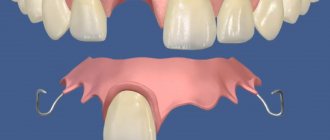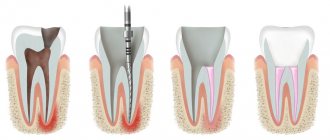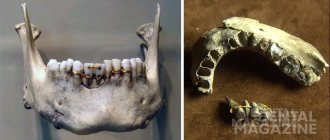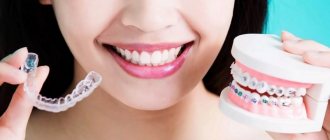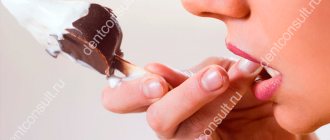When preparing for implant treatment, the patient learns many new words and terms, which are sometimes difficult to understand on their own. There are several key concepts that you need to understand the difference between.
The implant is an intraosseous part, has the shape of a screw and is installed by a surgeon into the bone.
Gum former – screwed onto the implant to form a beautiful and correct gingival contour
A crown is an orthopedic structure that is fixed to an implant. By the way, the periosteal part of both an artificial tooth and your own will be called a crown.
Abutment is an intermediate part between the implant and the crown. When the time comes to begin the actual prosthetics - making a crown on the implant - the doctor temporarily unscrews the former and takes impressions. When the crown is ready, the doctor will remove the former again, this time completely, and screw the abutment. In the oral cavity, the abutment represents a stump - a stump - on which the crown will be fixed.
What is an abutment in dentistry?
Almost any specialized Internet resource will tell you what an abutment is in dentistry, but it is quite difficult for an ordinary person to understand the endless variety of these orthopedic products and their capabilities. Let's start with the fact that all types of similar structures (with the exception of gum formers) have one common goal - to connect the implant and the crown. An implant without an abutment cannot perform its function. Moreover, the final result of treatment in terms of functionality and aesthetics largely depends on this important component. If at the dawn of implantology dentists had a rather narrow choice of prostheses, today almost all manufacturers produce several lines of orthopedic components. It is quite difficult for an ordinary person to understand the technical intricacies and design features of all types of abutments, but it will be useful to know their types.
Types of abutments
Conventionally, all manufactured abutments can be divided into several categories, which differ in scope and technical characteristics. The table below shows all the current types of abutments.
Standard abutment
Universal designs made from templates. They can have different shapes, diameters and sizes.
- Suitable for most situations.
- Acceptable price.
- It's pretty easy to find a replacement.
- The individual characteristics of the anatomy of the dental system are not always taken into account.
- Soft tissue aesthetics are often limited.
- In some cases, the workmanship is not of the best quality.
Custom abutment
Individual abutments take into account the anatomical features (shape of teeth and gums, bite nuances) of a particular patient.
The production of an individual abutment implies the presence of a 3D model of the jaw, which eliminates the slightest errors and deviations. The most common are custom zirconium abutments (higher grade products) and custom titanium abutments.
- High quality workmanship, custom compatibility.
- The best indicators of functionality and aesthetics.
- Excellent fit to the gum line, due to which no additional manipulation of soft tissues is required.
- High price.
Angled abutment
Such abutments are also called multi-unit. They are installed on implants that were implanted at a non-standard angle due to the anatomical features of the jaw structure and dentition. The angular abutment, by changing the angle of inclination of the longitudinal axis, allows for an optimal combination of implant and crown.
Ball abutment
Round-shaped ball abutments are used for mini-implantation. Most often, a removable denture is installed on ball-shaped abutments.
Temporary abutment (abutment - gum former)
A temporary titanium abutment is a plug that is placed after implantation of an artificial root and helps to form the desired soft tissue relief around the installed implant and future orthopedic structure. The healing abutment is installed while the implant is healing and subsequently removed. Also considered temporary are plastic abutments, which are used quite rarely.
One-piece designs
The implant and abutment are one unit. Such designs are most often used for simultaneous implantation.
Manufacturing (modeling) technique in the laboratory
- After the artificial root has healed and the gingival contour has been formed, an impression coping is screwed onto the implant to take an impression .
- The impressions are sent to a dental laboratory to make plaster models .
- The finished model is scanned and transferred to a computer program for modeling.
- An abutment is cut out of a solid block blank using a computerized machine using CAD/CAM technology .
»
Manufacturing of abutments - features of materials
There is a separate classification of abutments according to the type of materials from which they are made. Today, the material is of significant importance, since not only the functional, but also the aesthetic result comes to the fore.
Titanium
Titanium abutments are considered one of the most popular on the market. They are distinguished by strength, reliability and reasonable price. On the other hand, titanium abutments are not always suitable for esthetic restorations, as they can show through the crown.
Zirconium
Zirconium abutment is a modern and quite expensive solution for prosthetics. The highest cost is a custom abutment made of zirconium dioxide. These abutments combine strength and aesthetics.
Combined
It is usually an alloy of titanium and zirconium. They allow you to achieve good functional and aesthetic indicators, but at the same time they have a rather high cost and are not offered by all manufacturing companies.
Ceramic
A good option for those who are allergic to metal components. In addition, such abutments are used for aesthetic restorations in the frontal area.
Plastic
The cheapest plastic abutments designed for temporary restorations.
Oral care after installation
Personal oral hygiene is important after installation of an abutment and helps reduce the risk of possible complications.
The oral cavity should always be kept clean to prevent infection. In the first days, treatment of the abutment and surrounding tissue may cause discomfort, but this will soon disappear. For several days after installation of the structure, it is recommended to limit yourself to rinsing the mouth so as not to damage the wounds. Then you need to use a soft toothbrush. The dentist can also recommend specific hygiene products that will improve oral hygiene.
Installing an abutment on an implant
The one-stage implantation technique involves installing an implant and abutment (most often it is a one-piece structure) in one visit to the doctor. If we consider the classic two-step technique, then the installation of the implant, abutment and crown is carried out in several steps:
- preliminary procedures before implantation (consultation, tests, photographs, etc.);
- surgical stage of implantation with installation of a temporary gum former;
- installation of abutment after implantation.
When installing the abutment directly, two types of fastening are used.
Abutment fixation
Cement fixation is carried out using a special cement-based material. A simple and aesthetic method, the disadvantages of which are difficulties in removing excess cement, as well as removing and replacing the prosthesis.
Screw fixation is the fastening of a prosthesis using a screw mechanism. A hole is made in the crown through which the abutment screw passes, after which the hole is closed with material and ground. This technique is safer from the point of view of inflammation, but the risk of structural failure is greater.
Possible complications
The most serious complication is implant rejection. It is accompanied by inflammation, pain and fever and requires urgent medical attention. In addition, the following complications may be present.
- Premature destruction of sutures, which provokes bleeding. To avoid it, it is important to follow a diet and not load the jaw during the recovery period.
- Severe growth of soft tissue. The problem requires urgent installation of a gum former, so you need to consult a doctor as soon as possible.
- Unreliable fixation of the crown. Most often caused by a violation of the abutment thread, which is a consequence of a manufacturing defect or installation defect.
- Implant loss. Possible due to excessive load or force.
It is important to know! You should not try to straighten or insert the implant yourself. In case of any damage, bleeding or inflammation, you should immediately consult a doctor.
Abutment replacement and manufacturing companies
An implant-abutment-crown is a structure consisting of several elements that, for a number of reasons, can break or fail. Replacing implants requires invasive surgery, but if you have a broken abutment, installing a new one is easier.
Abutments for implants (as well as additional orthopedic components) are produced by the same manufacturer. That is why, in order to quickly find a replacement, we recommend installing implants from well-known brands that have been around for more than one year. These do not necessarily have to be premium companies: today, economy class manufacturers are widely represented on the market, which, however, maintain an acceptable level of quality. If the doctor offers you products from new and unknown brands, be prepared for the fact that the company may cease to exist at any time, which will make it difficult to replace components.
Among the top companies, the most famous are Nobel Biocare, Straumann, Astra Tech, Ankylos, Xive. Budget brands of implants that you can definitely trust: Alpha Bio, MIS, Dentium, Osstem.
Screw type of crown fixation
With the screw type of fixation, the implant consists of two parts: a titanium screw and the crown itself. In this case, the abutment is integrated into the crown and forms one whole with it. And the biggest advantage of this implantation method is the absence of cement connecting material. In this case, the crown can be removed without damage, for example, if professional hygiene is necessary.
A distinctive feature of screw-retained crowns is a small hole in the middle of the chewing surface of the crowns (if we are talking about lateral teeth), and the palatal or lingual surface of the incisors (if these are front teeth), which is tightly sealed with a composite material matching the color of the crown.
To be able to manufacture screw-retained crowns, it is necessary to clearly plan the position of the implant using a surgical template. Otherwise, if the implant is installed at a large angle, you will have to resort to a cement type of fixation.
This is why our doctors pay so much attention to diagnostics and planning in order to determine in advance the position of the implant in the bone tissue relative to the dentition and choose the type of fixation of future crowns. This is important for successful and efficient work.
Painless implantation by our experienced doctors:
- high survival rate of more than 98% , which is higher than the international average of 96%
- the best anesthesia that is suitable for 100% of patients
- implantation in perfectly sterile conditions - no infections
- is possible in 1 day immediately after removal of a damaged tooth
- diagnostics using 23 parameters before implantation for high results
- extended warranty
- high-quality effective treatment at prices in the residential area of Yasenevo
Prices for abutments in dentistry
The cost of implant abutments depends on the type of product, brand and clinic that offers the treatment.
| Implant abutment price |
| Standard abutment: price starts from 2,000 rubles for a titanium product. |
| Individual abutment: the price starts from 4,000 - 6,000 rubles for a titanium product and can reach up to 15,000 rubles. |
| Zirconium dioxide abutment: from 8,000 to 30,000 rubles, depending on the brand and type of product. |
The cost of the finished structure also includes installation of crowns on abutments and implantation of a titanium root.
How is it different from standard
An individual abutment, unlike a regular one, is not a round stump, but a full-fledged tooth stump, similar to a natural crown sharpened for a prosthesis. Due to the fact that the standard adapter is much narrower, during fixation, excess cement flows into the space between the implant and the gum. An error can provoke tissue inflammation and rejection of the titanium root in the early or medium term. Such consequences can be easily prevented by installing an individual design.
«

